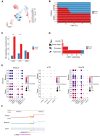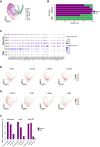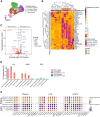IRescue: uncertainty-aware quantification of transposable elements expression at single cell level
- PMID: 39271103
- PMCID: PMC11514465
- DOI: 10.1093/nar/gkae793
IRescue: uncertainty-aware quantification of transposable elements expression at single cell level
Abstract
Transposable elements (TEs) are mobile DNA repeats known to shape the evolution of eukaryotic genomes. In complex organisms, they exhibit tissue-specific transcription. However, understanding their role in cellular diversity across most tissues remains a challenge, when employing single-cell RNA sequencing (scRNA-seq), due to their widespread presence and genetic similarity. To address this, we present IRescue (Interspersed Repeats single-cell quantifier), a software capable of estimating the expression of TE subfamilies at the single-cell level. IRescue incorporates a unique UMI deduplication algorithm to rectify sequencing errors and employs an Expectation-Maximization procedure to effectively redistribute the counts of multi-mapping reads. Our study showcases the precision of IRescue through analysis of both simulated and real single cell and nuclei RNA-seq data from human colorectal cancer, brain, skin aging, and PBMCs during SARS-CoV-2 infection and recovery. By linking the expression patterns of TE signatures to specific conditions and biological contexts, we unveil insights into their potential roles in cellular heterogeneity and disease progression.
© The Author(s) 2024. Published by Oxford University Press on behalf of Nucleic Acids Research.
Figures






Similar articles
-
scPanel: a tool for automatic identification of sparse gene panels for generalizable patient classification using scRNA-seq datasets.Brief Bioinform. 2024 Sep 23;25(6):bbae482. doi: 10.1093/bib/bbae482. Brief Bioinform. 2024. PMID: 39350339 Free PMC article.
-
LocusMasterTE: integrating long-read RNA sequencing improves locus-specific quantification of transposable element expression.Genome Biol. 2025 Mar 26;26(1):72. doi: 10.1186/s13059-025-03522-9. Genome Biol. 2025. PMID: 40140852 Free PMC article.
-
SARS-CoV-2 infection mediates differential expression of human endogenous retroviruses and long interspersed nuclear elements.JCI Insight. 2021 Dec 22;6(24):e147170. doi: 10.1172/jci.insight.147170. JCI Insight. 2021. PMID: 34731091 Free PMC article.
-
Identifying cell types to interpret scRNA-seq data: how, why and more possibilities.Brief Funct Genomics. 2020 Jul 29;19(4):286-291. doi: 10.1093/bfgp/elaa003. Brief Funct Genomics. 2020. PMID: 32232401 Review.
-
scRNA-seq data analysis method to improve analysis performance.IET Nanobiotechnol. 2023 May;17(3):246-256. doi: 10.1049/nbt2.12115. Epub 2023 Feb 2. IET Nanobiotechnol. 2023. PMID: 36727937 Free PMC article. Review.
Cited by
-
Transposable elements as genome regulators in normal and malignant haematopoiesis.Blood Cancer J. 2025 May 6;15(1):87. doi: 10.1038/s41408-025-01295-9. Blood Cancer J. 2025. PMID: 40328728 Free PMC article. Review.
-
Dynamic dysregulation of retrotransposons in neurodegenerative diseases at the single-cell level.Genome Res. 2024 Oct 29;34(10):1687-1699. doi: 10.1101/gr.279363.124. Genome Res. 2024. PMID: 39424325 Free PMC article.
References
-
- Lanciano S., Cristofari G.. Measuring and interpreting transposable element expression. Nat. Rev. Genet. 2020; 21:721–736. - PubMed
MeSH terms
Substances
Grants and funding
LinkOut - more resources
Full Text Sources
Medical
Molecular Biology Databases
Miscellaneous

